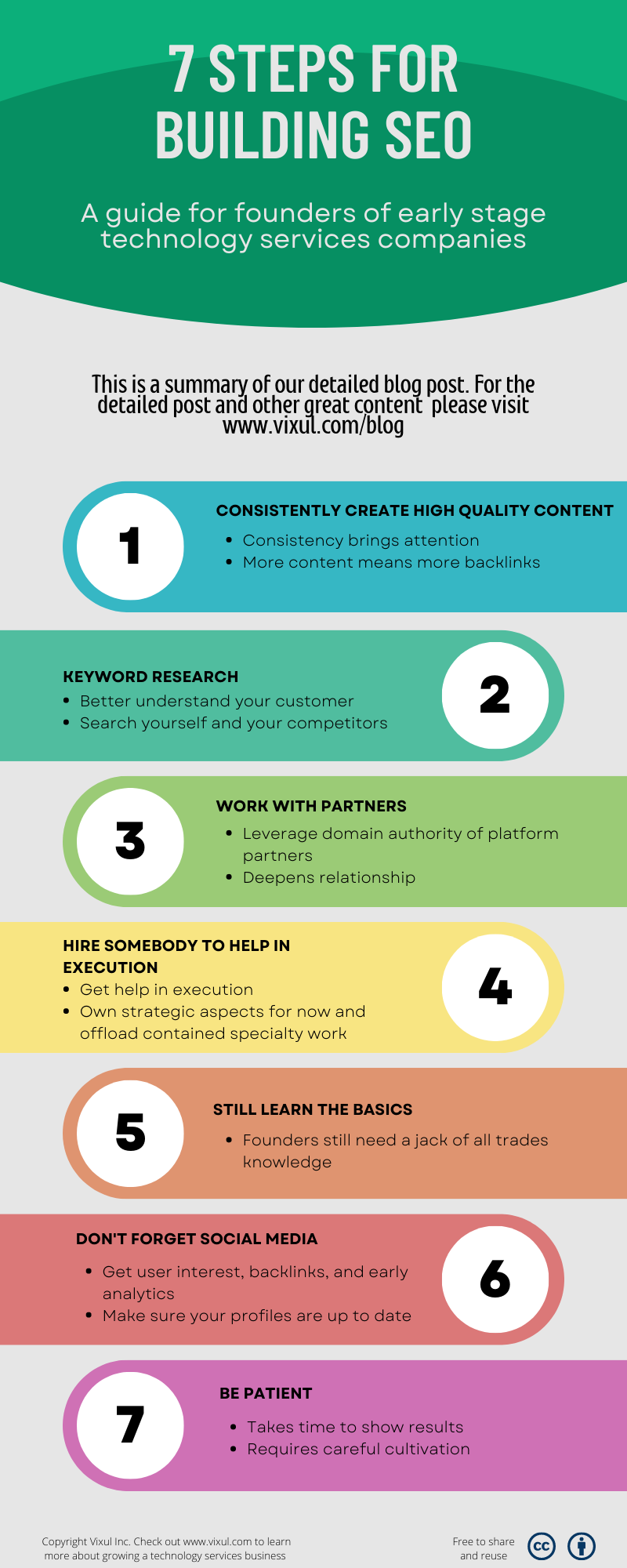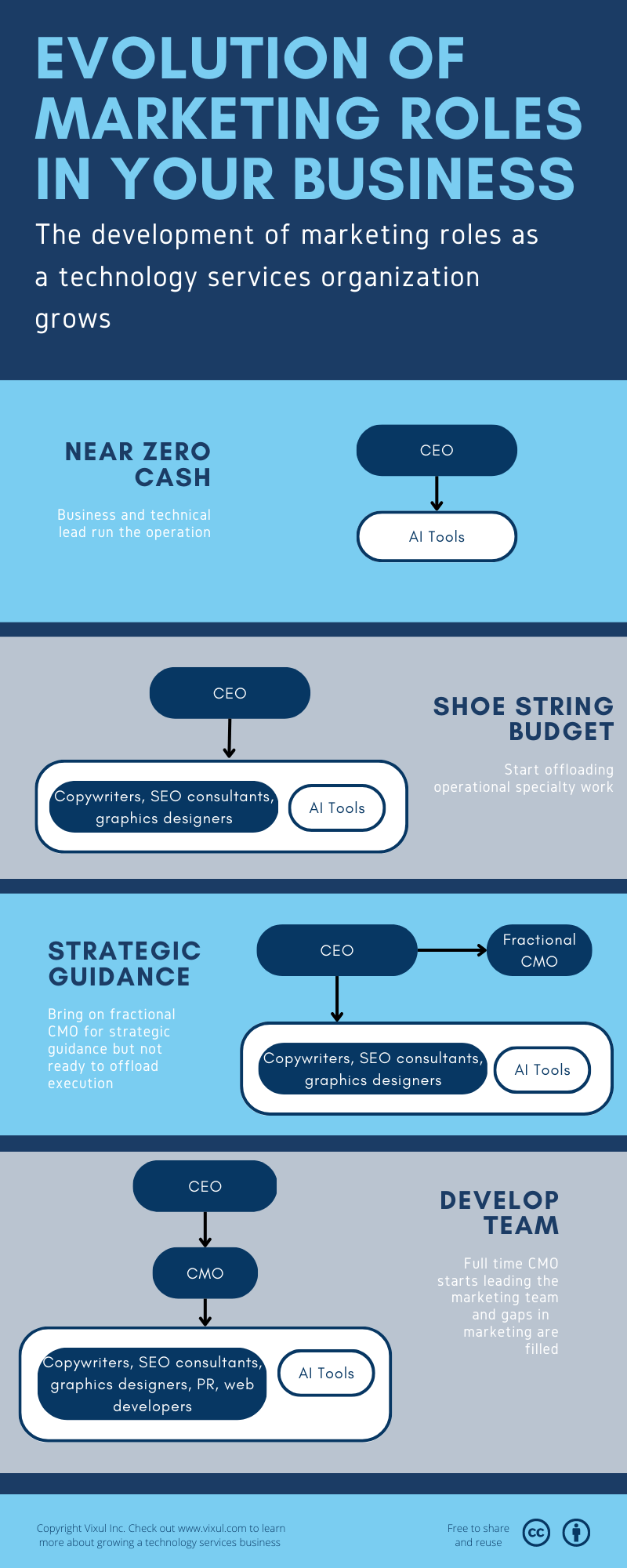As we discussed in our article Default Alive Or Dead: A Tech Services Perspective, tech services...
7 Steps For Tech Services Founders To Kickstart SEO
In our previous post we talked about the importance of Search Engine Optimization (SEO) for technology services companies. But early stage founders may find the idea of SEO overwhelming. So in this post we provide a practical step-by-step guide for the founders of early stage technology services companies to use SEO to improve their discoverability.
In this post we will cover the topics a founder of an early stage services company needs to know about and the extent to which they need to know about it. We also have an understanding that they are likely not coming from a marketing background. They are too early to hire a good CMO that can give them the right guidance but need to start establishing their web presence today so it is there when the company is ready for it.

Step 1: Consistently Create High Quality Content
We talked about the importance of content in our posts here and here. And of course if you want to have your content be found on search engines you need to have content in the first place. But the impact of this on SEO goes beyond the obvious. It's not just the amount of quality content you have will create more references to your domain increasing your domain authority. Search engines want to point to up to date high quality content. Posting regular content will get search engines to index you more frequently. It also gives you more excuses to share content without being repetitive and spammy resulting in more people creating references to your content.
Step 2: Keyword Research
The next step is the actual SEO campaign. The first step in any successful SEO campaign is keyword research. This involves identifying the keywords and phrases that your potential customers are using to search for solutions to their problems. Use keyword research tools such as Google Keyword Planner, SEMrush, or Ahrefs to conduct the research. You are looking for answers to the following questions:
-
Understand what keywords your customers are searching for. Try keywords in your domain and start seeing the traffic and the difficulty in ranking on those keywords. Identify high-volume, low-competition keywords that you can target in your content.
-
Look at your own domain and see what keywords you are ranking on. This will give you an understanding of what content is organically getting popular. For example by examining www.vixul.com we discovered that our "The 5 Essential KPIs For IT Services Founders" garnering attention on keywords like KPIs for services companies. Social Media stats provided a second confirmation of consumer interest in reading about KPIs for founders. And so we have more content planned in our calendar around KPIs relevant to IT services founders.
-
Look at competitors. This is again for similar reasons to researching yourself. Seeing what is working for your competitors would help you understand what keywords, type of content, and messaging is working for your competitors. That way you can benefit from their research in your own work. When you're doing this be broad in your understanding of who a competitor is. In this context a competitor is not someone that does the same work you do, rather a competitor is someone that steals attention away from you. For Vixul, we are looking at product accelerators like YCombinator, mastermind groups like Vistage and Collective 54, management consulting services like Equiteq. Each of them giving insight into how our customers are searching for problems, and what content is interesting them.
You will use the learnings from your keyword research into designing your content. Just remember the goal is still to produce high quality content and establish thought leadership. If you don't do that then the content will not help you in closing business which is the purpose behind the content work you're doing. So your content needs to be meaningful to your customers.
Step 3: Work With Partners
Partners are a big component of business development for technology services companies. They provide leads, give credibility, provide focus, give terms and skills your customers are searching for. So partners, in particular platform partners should be a major part of your overall strategy. But they have an additional advantage when talking about SEO. Being large and credible they usually have a high amount of traffic and domain authority you can leverage if you can get them to reference you. These are some of the tactics you can use to have your platform partners create backlinks for you:
-
Reach out to the marketing departments with original research that highlights the benefits of platforms over their competitors. This is especially useful if you are perceived as neutral. For example we wrote a white paper comparing the performance of different Hadoop distributions. Our research showed that MapR had a significant performance advantage, up to 10x in write throughput. This got us attention from MapR and we were invited to write a guest post for MapR. In the guest post we shared a summary of our findings, the impact, and call to action to download our whitepaper for more details directing traffic to ourselves.
-
How to content, especially based on real world usage is extremely valuable to all platforms. At Flux7, we were published on the AWS blogs quite frequently because AWS wanted to showcase details on how real customers are creating innovative solutions.
-
When dealing with a large platform like AWS, establish relationships with the product teams relevant to you. This should be a part of your general strategy for penetrating the partner but there is a lot of competition for getting on the general blogs. But the different product teams have their own blogs by and it is easier to make guest posts for them because you can make targeted content meeting their needs. You should also remember your target audience. For a technology services company it is very likely that your website content is targeting the technical teams and have other strategies for executives. The technical teams are more likely to be reading the detailed product team blogs than the more general main blogs.
-
Co-host events while taking a lead on designing the content. Host the assets on your website. These events also generate high quality leads and show thought leadership and are definitely worth the investment. Just be sure to leverage the SEO benefits during the process.
-
Do joint development. Many platforms have innovation credits that they can provide to partners for interesting work. If you can convince your partner to sponsor innovation work you get easy business, highly credible content that puts you forward as a thought leader, and marketing for the innovation work you do for the partner.
These are just some of the ways you can get critical partners to share their credibility with you when developing your own credibility with search engines. The best part is that all of these are an extension of the work you would already be doing for strengthening your partnerships. Just to make sure to have them share their readership with you. Keep in mind that the bottleneck for your partners is great thought leadership and they are more than happy to share credit with you when you create something of value to them.
Step 4: Hire Somebody To Help In Execution
Sorry if this sounds like cheating. But as the founder you are busy. You need to not try and do it all yourself. There are a lot of things that need to be done to extract the maximum value out of your content. There are other demands on your time. There are many details that need to be followed. There is a high amount of domain knowledge. There are many people that excel at this skill and can provide reasonable service at an affordable price. You don't need the best of the best but you need to get someone helping you as soon as possible. A part-time contractor can solve many of the problems including, fixing the website for SEO issues, optimizing content, and creating backlinks. You have a domain expertise. Respect the domain expertise of others and get help the same way you're expecting your customers to get help from you in your domain expertise.
You will have to hire for this role while you are still on a survival shoestring budget. The help you are looking for is:
-
Specialty content creation e.g. videos and graphics
-
Backlink creation
-
Optimizing content
-
Fixing website issues
-
Marketing automation
Please note this order is not the order of importance of the activities. In fact it is closer to the opposite to the order of importance. It is the order in which you will be getting help because the activities are more self-contained, a common skillset, and are not as time consuming.

Step 5: Still Learn The Basics
While you do not need to become an expert in SEO, like all other parts of the business the founders need to have a top-level understanding. You will need this understanding to be able to make sense of the advice you are receiving from your SEO hires. It also will help you translate the results the SEO team is looking at in terms of viewership, domain authority, ranking keywords into value to your business. So you can tune the goals of the SEO team to your needs. Finally with you understanding the goals of SEO the work you are already doing would have the appropriate filter applied to it. You would naturally include keywords into your posts, create internal links to increase time on page, use graphics to attract attention and fill alt text to improve searchability and accessibility ratings. You don't need to stress about mastering the content. But spending some time getting a basic understanding will help you leverage your marketing employees better. Neil Patel and Hubspot are excellent resources to start.
Step 6: Don't Forget Social Media
In your attempts to be discoverable social media marketing is as important as SEO. SEO will find the people looking for the solutions that you provide but social media will get you the attention of people that have not yet started looking for a solution. Posting on social media also gets you the attention of an audience that already respects your profile. They make great visitors to you website because they will bring great time on page rankings. In addition it will generate more backlinks for your site as you attract people's interest. Social media profiles can rank for search terms so you need your social media profiles to be an effective way to get business. Finally it takes a long time to establish sufficient data on SEO but social media gives you daily analytics on the interest your posts are generating.
Step 7: Be Patient
SEO is a long term investment into the company. It is not going to generate immediate results in the form of leads. You will need to be patient before you get to that stage. But this patience that is needed is the patience of a farmer. Farmers patiently waits for the harvest but is not idle during that time. They are continuously monitoring, nurturing, and caring for their crop. In the same way, you must continue to produce great content, monitor the important metrics to ensure you are making progress and better understand what sticks. Check out this article on metrics to monitor on Semrush. Since the Social Media metrics will provide more immediate feedback also check out this article by Hootsuite on metrics to monitor on Social Media. Both of these together will give you an understanding of how you are performing on the discoverability of your content.
These steps will enable you to kickstart your SEO strategy as a founder. Focusing on what you need to be involved in and depending on others for what is not needed. Following the steps on this post will put you in a strong position as you grow and can afford a full marketing team and need to scale your sales. But that is a difficult but fulfilling journey. To help you in this journey we will share a white paper "3 Reasons Why Growth Of Your Technology Services Startup Is Slow". Please subscribe to be included in the early access for this white paper.




